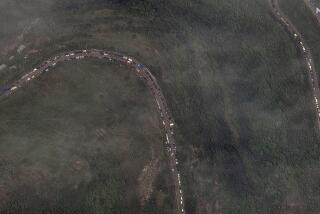Changing Lifestyles : Armenia the Bountiful: A Lesson in Land Reform : * Speedy privatization has doubled some harvests and cultivated pride and hope for a better future.
- Share via
AYNTAP, Soviet Union — Gagik Hambartsumyan swept his calloused hand toward the half-acre of crawling cucumber vines in a classic farmer’s gesture, looking out over his own--truly his own--small hunk of Armenia’s Ararat Valley.
“Everything you see here is ours,” Hambartsumyan said solemnly, his gangly, 16-year-old son at his side.
Throughout the Soviet Union, the land reform so desperately needed to reduce food shortages is bogged down by reluctant bureaucrats, local conflicts and equivocal laws. The collective farms forcibly imposed on the peasantry under Josef Stalin’s bloody reign remain the rule.
But in Armenia, the smallest of the remaining 12 Soviet republics, the government has gone ahead and given land to private farmers. And in the process, Armenia--despite some of the country’s poorest soil--has given the rest of the country a lesson in what land reform can accomplish.
Beginning last autumn, Armenian officials worked out laws and guidelines on parceling out most of the republic’s largely arid, mountainous land. In the spring, in time for planting, local government councils broke up more than 80% of the collective farms that had controlled Armenian agriculture for more than half a century and sold the land for nominal amounts to virtually any rural residents who wanted to cultivate it.
Now, with about two-thirds of available land privatized, Armenians say they can already see the difference in the bountiful fall harvest--and in their own attitudes toward farming.
“The people work night and day, and so do their children and grandchildren,” said Gagik Gasparyan, mayor of the valley town of Ararat and himself one of the republic’s first private farmers.
Gasparyan and other officials and farmers estimated that production of tomatoes, cabbage and other crops has doubled compared to last year, and they predicted that the harvests will continue to increase.
Hambartsumyan’s eyes light up when he talks about the future--an optimism exceedingly rare in the troubled republics of the collapsing Soviet empire.
“I see very good things ahead,” the 37-year-old former state farm foreman said. “With more farmers and more food, prices will go down. And if products are less expensive, we’ll live better.
“I’ll leave my farm to my children; that’s the way it should be,” Hambartsumyan said. As for now, “we’re a little afraid of winter, but we can get through it OK, just so long as we have freedom.”
Armenia’s land reform is turning into a success story, not only by Soviet but also by international standards, said Vahram Nercissiantz, a World Bank specialist who advises the Armenian government in his spare time.
“I don’t recall any other country which has done such far-reaching reforms in agriculture in such a short time,” Nercissiantz said.
For visitors from the Russian Federation--where even President Boris N. Yeltsin’s radical government has succeeded in privatizing only a tiny portion of the vast republic’s land and where collective farms retain an iron grip on their holdings--the Armenian reform is astounding.
“You just have to do it,” said Gagik Shakhbasian, vice chairman of the Armenian government’s Committee on Economics, which oversees the reform.
Armenian President Levon Ter-Petrosyan and his government, non-Communists who were swept to power in elections last summer and who remain extremely popular, moved much more decisively to redistribute the land than did their counterparts in the Russian Federation, where much of the populace still opposes private ownership of land.
Instead of leaving the job up to the chairmen of collective farms, as Russia has done--thus putting the reform into the reluctant hands of those who have the biggest personal stake in the old system--the Armenians affirmed that local councils legally owned all the land and thus had the right to parcel it out.
In the Massis district of the fertile Ararat Valley, council member Karlen Mikaelian said this meant that village councils were free to ask all residents who wanted to work the land to declare themselves and then to sit down with a map of the area and pencil in lot boundaries.
Once it was divided into plots of about two-thirds of an acre, the land in most villages was handed out by lottery, with about one plot allotted to every three family members. The cost was kept low--generally less than $600 per plot.
In two years, Shakhbasian said, farmers will gain the right to buy and sell land freely, and many of the smaller lots will probably be united into larger farms as some families choose to reap the profit from the land and use the money to go into other businesses.
The government still helps with fertilizer, seeds, chemicals and other technical services, but these too will eventually be largely privatized, Shakhbasian said.
He acknowledged that, with its poor mountain soil, low rainfall and current need to import about 1 million of the 1.3 million tons of grain that it consumes each year, Armenia can probably never be truly self-sufficient in agriculture. And with a tiny 0.13% of Soviet territory and just over 1% of the union’s population, it can have little effect on the overall Soviet food shortage problem.
However, Shakhbasian said, Armenia can improve its own lot, serve as a model of how farmers can help both themselves and their nation and show how--given the political will--land reform can become a reality.
The reforms are paying off. Hambartsumyan said that he has already earned 10,000 rubles this year--$5,730, according to the commercial exchange rate--by selling his produce at farmers’ markets or to store owners. That contrasts with maximum earnings of $2,292 in a good year on the collective farm.
Hambartsumyan likes the money and the freedom to decide when and how he works and sells his produce. But most of all, he and his family said, they enjoy the empowerment of ownership.
“Are there really people who are happy without their own property?” asked Gagik’s 69-year-old mother, Vartush, as she sat in the cool of the concrete house the family is still building and treated guests to tan , a watered yogurt beverage. “What you’re drinking now is from our own cow!”
Before privatization allowed the family to buy its cow, she would have to get up at 3 a.m. to get in line to buy milk at 8 a.m. “Now, you just go milk the cow and you have milk,” she said.
Hambartsumyan’s pride of ownership shows in his attitude toward his fields. Strolling along the cucumber patch and describing his plans to plant grapes and tomatoes, he stopped repeatedly to riffle through the leaves and pluck a choice cucumber or two. Soon, his hands were so full he had to cradle them in his arms.
On the collective farm, Hambartsumyan said, workers go once or twice to harvest and leave the rest rotting in the fields.
“When it’s your own,” he said, “you do it right.”
More to Read
Sign up for Essential California
The most important California stories and recommendations in your inbox every morning.
You may occasionally receive promotional content from the Los Angeles Times.













